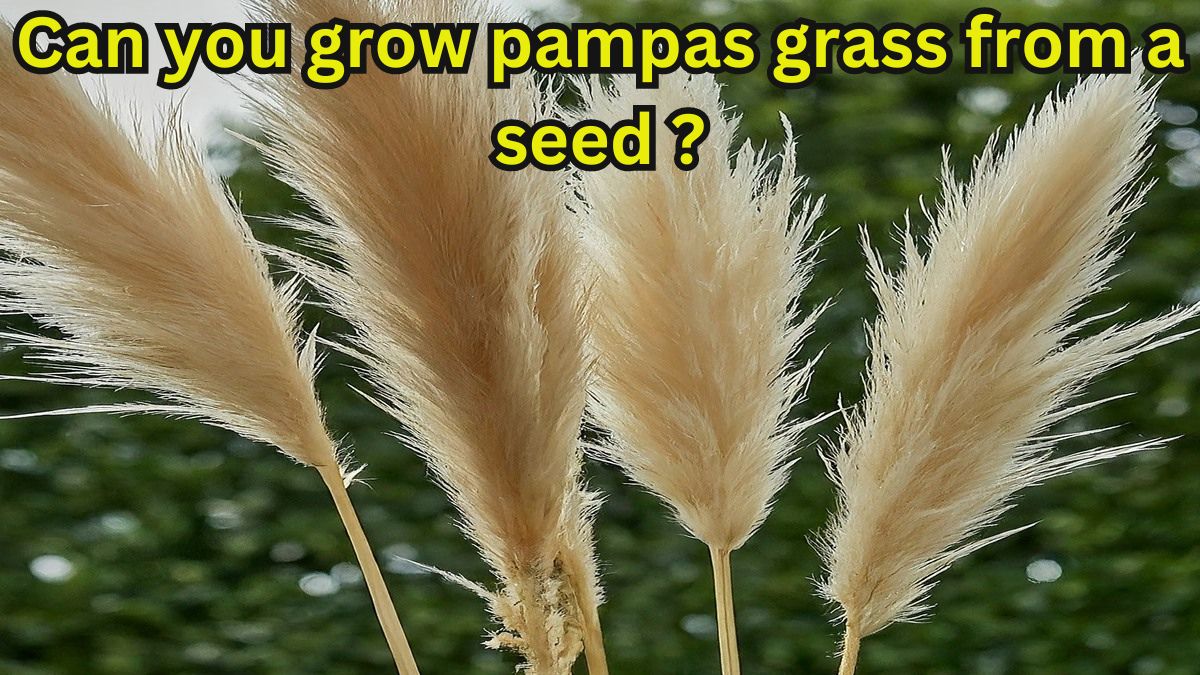Hello everyone! Today, we’re going to talk about pampas grass. You’ve probably seen this tall plant with fluffy tops around. A lot of people like it and want to grow it in their gardens. But the big question is: Can you grow pampas grass from a seed? In this blog post, we’re going to find out. We’ll learn all about how to grow pampas grass starting from just a small seed. So, if you like gardening or you’re just curious, keep reading as we learn more about pampas grass seeds.
Can You Grow Pampas Grass from Seed?
Yes, you can grow pampas grass from seed. Here’s a simple overview of the process:
- Seed Collection: The first step is to collect the seeds. You can do this by cutting off the fluffy tops of pampas grass in late summer or early fall. These tops contain the seeds.
- Seed Preparation: Next, you’ll need to prepare the seeds for planting. This usually involves soaking the seeds in water for about 24 hours. This helps to soften the seed coat and makes it easier for the seed to germinate.
- Planting the Seeds: After soaking, you can plant the seeds. It’s best to do this in the spring. Plant the seeds in a well-draining soil mix, about a quarter of an inch deep. Make sure the soil is kept moist but not waterlogged.
- Germination: With the right conditions, the seeds should start to germinate in about 3 to 4 weeks. You’ll see small shoots starting to emerge from the soil.
- Transplanting: Once the seedlings have grown a few inches tall, they can be transplanted to their final location. Pampas grass needs plenty of space to grow, so make sure to plant them at least 6 feet apart.
- Care and Maintenance: Pampas grass is a hardy plant and doesn’t require much care. However, it does best in full sun and well-draining soil. Water it regularly during dry periods, and cut back the old growth in early spring to encourage new growth.
Selecting the Right Seeds
Choosing the right seeds is the first step towards successfully growing pampas grass. Here are some tips and sources for purchasing high-quality seeds:
Tips for Choosing High-Quality Seeds:
- Reputable Supplier: Always opt for reputable seed suppliers or nurseries. This ensures that you’re getting high-quality, viable seeds that are free from pests and diseases.
- Fresh and Viable: Look for seeds that are fresh and viable. Fresh seeds have a higher germination rate.
- Suited to Your Climate: Choose seeds that are suited to your climate. Some popular varieties of pampas grass include ‘Rosea,’ ‘Pumila,’ and ‘Sunningdale Silver’.
- Seed Appearance: Pampas grass seeds are typically tan or beige in color and can vary in size, depending on the variety.
Sources for Purchasing Seeds:
- Garden Centers and Nurseries: You can purchase pampas grass seeds from local garden centers and nurseries.
- Online Seed Retailers: There are many online seed retailers where you can find pampas grass seeds. For example, Amazon has a variety of pampas grass seeds available.
- Specialized Plant Shops: Specialized plant shops often carry a variety of seeds, including those for pampas grass.
Preparing the Soil and Planting Area
Preparing the soil and planting area is a crucial step in growing pampas grass. Here are some tips and information on the ideal soil composition and pH levels:
Soil Preparation Tips:
- Clear the Area: Start by clearing the planting site of any debris, rocks, or existing vegetation.
- Improve Drainage: Pampas grass prefers well-draining soil and is sensitive to waterlogged conditions. If your soil is very dry and sandy, mix in some compost to help retain moisture. If you have heavy clay soil, amend it to improve drainage.
- Enrich the Soil: Add organic compost, peat moss, or manure to the soil to enrich it and promote good drainage.
- Till the Soil: Tilling the soil helps to aerate it, which is beneficial for the roots of the pampas grass.
Ideal Soil Composition and pH Levels: Pampas grass thrives best in a specific type of soil. The ideal soil for pampas grass is well-drained and fertile. It should be slightly acidic to neutral in pH, ranging from 6.0 to 7.5. This type of soil allows the roots of the pampas grass to easily absorb the nutrients they need to grow strong and healthy. The soil should also be loose and not compacted to allow the roots to spread out and establish themselves.
Sowing the Seeds
Here are the detailed instructions for sowing pampas grass seeds:
- Choose the right container: You can use any container filled with a mix of peat moss and sand. The container should have good drainage to prevent waterlogging.
- Prepare the soil: The soil should be rich and well-draining. You can enrich the soil with compost to promote drainage.
- Sow the seeds: Pampas grass seeds are small and fluffy, with a feather-like texture. Sprinkle the seeds on the soil surface. If you’re starting indoors, plant the seeds 6mm deep in a tray of seedling compost.
- Spacing considerations: Estimate the number of seeds to plant, depending on the desired size of the grass clump. Pampas grass can grow quite large, so ensure there’s enough space between each seed.
- Maintain moisture: After sowing, mist the soil until it is moist but not soaking wet. Cover the container with clear storage wrap or a storage bag to maintain humidity.
- Place in a sunny spot: Place the covered container in a sunny spot. The ambient temperature should be around 70 degrees Fahrenheit.
- Wait for germination: The seeds should start to germinate in about 2 to 3 weeks.
Watering and Caring for Seedlings
Here are some tips on watering and caring for pampas grass seedlings:
Watering Schedule and Techniques
- Initial Watering: After sowing, water the soil until it is moist but not soaking wet. Cover the container with clear storage wrap or a storage bag to maintain humidity.
- Regular Watering: Water your plant once a week or twice in particularly hot, dry conditions for the first year. If your climate is hot and dry, water once every two to three weeks.
- Drought Tolerance: Pampas grass is drought tolerant. Established grasses should receive plenty of water from natural rainfall unless there is an extreme drought. For new plants, water them deeply right after planting.
Protecting Young Plants from Pests and Diseases
- Pests: Pampas grass plants are generally resistant to most pests, but aphids and mites can be an issue. If you see them, consider using insecticidal soap.
- Diseases: Pampas grass may also fall victim to powdery mildew, rust, and anthracnose. These issues can be avoided by providing an area with full sun, well-draining soil, and good circulation.
- General Care: Remove all dead leaves and debris from around the plant, as this can attract pests and disease. Dispose of the trimmed grass and debris properly. After trimming, you can add fertilizer to the soil to promote new growth.
Transplanting and Ongoing Care
Here’s how you can transplant pampas grass seedlings and provide ongoing care:
Transplanting Seedlings
- When to Transplant: The best time to transplant pampas grass is in the spring before any new growth has started.
- Prepare the New Location: Choose a sunny spot in your garden with well-draining soil. Dig a hole that is approximately twice as wide and twice as deep as the transplant root ball.
- Transplant the Seedlings: Use a shovel to deeply dig around the base of the plant. Try to remove as many roots as possible, along with any associated garden soil. After digging, transplant the clumps into the prepared hole.
- Water Thoroughly: Water the new planting well and continue to routinely do so until the transplant has taken root.
Long-Term Care Tips
- Watering: Pampas grass is drought tolerant. Established grasses should receive plenty of water from natural rainfall unless there is an extreme drought. For new plants, water them deeply right after planting.
- Pruning: Prune the grass to the ground in late winter or early spring. This task should be done with great care using gloves and a long-sleeved shirt due to the plant’s sharp foliage.
- Fertilizing: If you wish, add a well-balanced fertilizer after pruning in the late winter or early spring to encourage new growth.
- Location: Keep pampas grass away from structures, outdoor cooking areas, or open flames because it is highly flammable.
Benefits of Growing Pampas Grass
Growing pampas grass in your garden or landscape can have several benefits:
Enhancing Garden Aesthetics
- Visual Appeal: Pampas grass is prized for its aesthetic appeal, adding a touch of elegance and texture to landscapes. Its tall plumes and graceful swaying in the wind can create a visually appealing focal point that enhances the overall beauty of your landscape.
- Variety of Colors: Pampas grass comes in a variety of colors, including white, pink, and silver, which can add a pop of color to your garden.
- Seasonal Interest: Pampas grass provides year-round interest in the garden. Its foliage remains attractive throughout the growing season, and its fluffy plumes persist into winter.
Practical Uses in Landscaping
- Natural Barrier: Pampas grass can act as a natural barrier, deterring children from frequently playing in areas where it is planted. It can also be used as a living screen or a border backdrop by planting a few pampas grass plants in a clump or several in a row.
- Erosion Control: Pampas grass is good for erosion control and is often used to stabilize stream banks and coastal landscapes.
- Wildlife Habitat: Pampas grass can provide shelter for birds and other wildlife.
- Drought Tolerance: Once established, pampas grass is known for its resilience and ability to withstand various environmental conditions, including drought.
Conclusion
In conclusion, growing pampas grass from a seed is not only possible but also a rewarding experience. With the right care and conditions, these seeds can transform into the majestic grass we admire in landscapes. Remember, patience is key as germination might take a few weeks. But once established, pampas grass is a hardy plant that requires minimal maintenance. So, whether you’re a seasoned gardener or a beginner, don’t hesitate to give growing pampas grass from seed a try.
FAQs
Here are some FAQs:
- What are the ideal conditions for growing pampas grass from a seed? Pampas grass grows best in hot and humid areas but can thrive even in colder regions, as long as it grows in full or partial sun, and well-draining loamy soil. It’s recommended to start them off indoors, sowing any time between February and April.
- How long does it take for pampas grass seeds to germinate? The seeds should germinate in about 2 to 3 weeks.
- What care should be taken after the pampas grass seeds have sprouted? Once the seedlings are large enough to handle, repot them into larger pots. For new plants, water them deeply right after planting. You may wish to water intermittently for the first few months to ensure that your grass receives enough water.
- Are there any common problems or pests to watch out for when growing pampas grass from a seed? Pampas grass grows quickly and readily self-seeds. This grass can quickly overtake other vegetation and is very hard to get rid of once planted. Before planting, be sure to find out whether this plant is listed as invasive or a fire hazard in your area.


